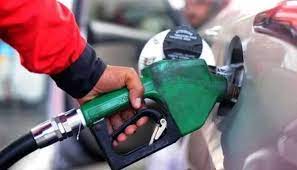Miftah said Prime Minister Shehbaz approved hiking the price of petrol, diesel, and light diesel by Rs30 per litre and kerosene oil had been hiked by Rs26.38 per litre, effective from June 3
ISLAMABAD: With the National Electric Power Regulatory Authority (Nepra) announcing the base tariff of electricity by a huge Rs7.9/unit from July 1, Finance Minister Miftah Ismail dropped another price bomb on people on Thursday saying that the price of petrol and diesel had been moved up by Rs30 per litre, a few days after increasing the rate of the commodity by the same amount.
Miftah, in a press conference, said Prime Minister Shehbaz Sharif approved hiking the price of petrol, diesel, and light diesel by Rs30 per litre, while the rate of kerosene oil had been hiked by Rs26.38 per litre, effective from June 3.
“…kerosene oil is the only commodity which is not leading to losses for the government. However, we are facing losses of Rs8 on light diesel, Rs9 on petrol, and Rs23 on high-speed diesel,” he said.
New prices (per litre) are: Petrol, Rs209.86; Diesel, Rs204.15; Light diesel, 178.31; Kerosene oil, Rs181.94. The finance minister admitted that the lower-income segment of society would be affected the most as a result of the petrol price hike, but noted that the rate of oil has also sky-rocketed in the international market.
Monthly Pakistan Affairs magazine.
To a question, the finance minister said he was hopeful of reaching an agreement with the IMF in June, but noted that there were some reforms that the government still had to do. “The IMF wants to see our budget, so the reforms that we want to introduce will be introduced before the budget. However, we are speaking to the IMF on a daily basis,” he said.
Miftah said the price-hike was inevitable as he had to strike a deal with the international money lender as ex-finance minister Shaukat Tarin of Imran’s government had “tied the government’s hands” due to the agreements he made with the IMF during his tenure. To a question, Miftah noted Pakistan would be willing to import cheap oil from Russia, provided that no sanction was imposed on Islamabad.
The finance minister confirmed that Chinese banks have agreed to refinance Pakistan with $2.3 billion worth of funds which is expected to shore up Pakistan’s foreign exchange reserves. In an earlier Twitter, Ismail wrote: “Good news. The terms and conditions for refinancing of RMB 15 billion deposit by Chinese banks (about $2.3 billion) have been agreed.”
Meanwhile, the National Electric Power Regulatory Authority (Nepra) announced increase in the base tariff of electricity by a huge Rs7.9 per unit to a historic high national average tariff of Rs24.82 per unit for the power consumers. This decision is part of government efforts to meet the International Monetary Fund’s (IMF) conditions to revive the stalled aid programme.
The multilateral lender has asked Pakistan to eliminate the subsidy on petroleum products and electricity to lower the fiscal deficit. Late last month, the lender’s demand increased Petroleum products’ prices by Rs30 per litre (or over 20 per cent). The government further intends to increase the prices in the coming days to end the multi-billion rupees subsidy.
While announcing the increase in power tariff, the power regulator suggested to the Federal government notify the rise, as, after its nod, the decision would be implemented from July 1, 2022.
Nepra said that with the increase of Rs7.9078/unit tariff, the national average tariff of Rs24.82/unit from the current tariff of Rs16.91/unit. It further said that the increase in tariff is made on account of a hike in fuel prices, capacity charges of the plants (mostly IPPs), and rupee devaluation.
The regulator also said that the energy purchase price was projected at Rs1.5 trillion, while the cost of capacity charges was projected as Rs1.3 trillion. “Total revenue requirement of XWDiscos, including Discos margin and prior year adjustment, is projected as Rs2.8 trillion with projected sales of 113,001-gigawatt-hours (GWh),” it said.
The PTI government, in its tenure, had started raising the average tariff in a bid to avail IMF programme and reduce the power subsidies in two phases. It had created new tariff slabs to reduce power subsidies. After that, it increased power tariff by up to Rs0.95 per unit for domestic consumers to cut subsidies under the Re-Targeting Power Sector Subsidies-Phase Il to burden the consumers with an Rs20 billion additional burden annually.
Under the Re-Targeting Power Sector Subsidies-phase 1, Nepra had allowed the federal government to increase electricity tariffs to Rs1.68 per unit from Nov 1, 2021, to phase out power subsidies.
The power regulator had also created new tariff slabs, further eliminating subsidies. Due to an increase in the base tariff, the government was reportedly collecting Rs135 billion extra annually. The PTI government had removed around 8 million consumers from the subsidy network – reducing the number from 22 million to 13.9 million.
Meanwhile, Moody’s Investors Service (Moody’s) on Thursday downgraded Pakistan’s outlook to negative from stable. It affirmed Government of Pakistan’s B3 local and foreign currency issuer and senior unsecured debt ratings.
“The decision to change the outlook to negative is driven by Pakistan’s heightened external vulnerability risk and uncertainty around the sovereign’s ability to secure additional external financing to meet its needs,” read the statement.
The ratings agency said Pakistan’s external vulnerability risk has been amplified by rising inflation, which puts downward pressure on the current account, the currency and – already thin – foreign exchange reserves, especially in the context of heightened political and social risk.
“Pakistan’s weak institutions and governance strength adds uncertainty around the future direction of macroeconomic policy, including whether the country will complete the current IMF Extended Fund Facility (EFF) programme and maintain a credible policy path that supports further financing,” it stated.

